| Whitewater Rafting Arunachal Pradesh: River Running Shangri La
|
|||||
It is this incredible white water destination that we travelled when we signed up with the 2 Mountain Division of the Indian army in 1994. Our expedition was to initiate their combat units to river running, and by extension, rafting the main rivers of the state - the mighty Brahmaputra and its tributaries, the Lohit and the Subansari. |
More on A.P.
Rafting
Adventure activities | ||||
Having completed the first and second descents of the beautiful Subansari, we went on to the first major descent of the Lohit, starting at Kibithu, the eastern-most outpost of India, bordering China. From here, one can see the Chinese positions and a well-lit officers mess. The Lohit is an extremely difficult and scary river, quite easily among the toughest to run in Arunachal. It has continuous stretches of Grade V rapids. The end of each day was marked by our team of guides sitting in our tents with completely listless expressions, after the Herculean efforts of the day. The Lohit, was a river to challenge the wits of any river runner. This was something we learnt over five days and a hundred and thirty kilometers of steep, raging white water. It was only at Parashuram Kund, where the Lohit enters the plains, that one could begin to relax without having to gear up for the onslaught of the next Grade V. The run-up to the Brahmaputra began with an airlift in a Russian AN-32 transport aircraft with our equipment. We came to a small village completely devoid of communication with the outside world. Tuting lies very close to the international boundary with China and is probably the only place in the world where the Air Force is used to transport civilian population on a regular basis. The river seemed big - even from the air, a speculation which was confirmed again and again over the next 12 days.
At 1800 miles long, it is longer than the Ganges, and it contributes more alluvium to their joint delta at the head of the Bay of Bengal, than its sister river. Its name means "son of Brahma" after one of the three main gods of Hinduism. In Tibet it is called the Tsangpo, "the Purifier". Statistics aside, the Brahmaputra has earned its greatness as the world's highest navigable river of any length and for cutting the deepest gorges in the world. For some 400 miles at 12,000 ft, small boats made of bamboo and hide, called caracles, trade between major cities of Tibet. An air reconnaissance by enthusiastic river runners a few years back termed this as "one section of white water which will never be run". In September, 1998, National Geographic sponsored an expedition to charter this gorge with a team of kayakers attempting an alpine style descent supported by a support crew on land. It failed when a very experienced U.S kayaker, Douglas Gordan lost his life on running an 8 ft drop in the gorge - his body was not found after four days of search and the expedition was called off. The "Big Bend" still awaits a complete descent. More recently, another expedition found on this river, what is the most fascinating discovery of the last century, "Rainbow Fall", a huge waterfall on the river, of a stature no one ever imagined to be existing till date.
The Adi villages dot the remote hills in clearings surrounded by leech-ridden rainforests. These tribes worship the Donyi-Polo (Sun-Moon) and this river is held in great awe and reverence, mostly due to the frightening volume of water it discharges each year. The Siang, like all rivers originating in the mountains, forms rapids due to loss of gradient, constrictions and obstructions, on its way to the plains. These rapids are graded on a scale of I to VI based on their size and the degree of difficulty encountered while negotiating them, Grade VI being unrunnable or suicidal. It is the size of these rapids, the surroundings and the sheer volume of water that make it a complete white water running experience. Our expedition completed a three day training of expedition members at Tuting, a few miles inside the line-of-control with China. The reputation of the Siang was well known since its first descent by an Indo-Japanese expedition. We began the task of drilling our respective crews into shape and teaching them various paddling techniques, rescue and raft flip drills and finally, familiarization with river hazards, features such as "holes", "breaking waves", "pourovers" and "haystacks", all of which can be major trouble in a rapid if not sighted or read in time. The key to rafting a river successfully is "white water reading", essentially the spotting of the hazards in a rapid, plotting a course through or around them and finally executing it, making sure the crew and clients come out of it safely after having had the time of their lives. The first day below Tuting, ten of us in two rafts accompanied by a safety kayaker got our first taste of big volume white water as we negotiated a big, constricted Grade IV+ rapid near the village of Ninguing. Rapids keep coming as the Siang pushes strongly. Another Grade V for the day and we beach for the night at Pango, awaited by a posse of the Indian army, armed with hot tea and pakoras, followed by an early dinner and campfire. What was disconcerting was a big rapid roaring away a short distance below our camp. A shot of rum and a good night's sleep turned out to be extremely therapeutic, before we woke to its roar and proceeded to run it.
Error in judgement cannot be accommodated - hitting water at the wrong angle can cause a "flip" within seconds. In seconds that seemed like a lifetime, the rapid was over, and we looked back with gaping mouths at what we had come through. In the calm, we recapitulated events as the rafts floated downstream, with various exchanges about everybody’s views of the last rapid. We reach Alubadi beach by late afternoon where an Adi tribal sold us oranges at ten for a rupee. The locals were delighted by the sight of the boats and one old lady had walked a couple of days to see our expedition. She had trouble relating to our lifejackets and helmets and thought that JD is an incarnation of the Donyi-Polo ! One can only be amazed at the power of this river, the culture and the people it has sustained on its banks. Breakfast Rapid is the first on day three, a big one with a history of raft flips. Increased heart beats, a rush of adrenaline, a desperate command for "Hard Forward" and it was behind us in a matter of a few seconds. It turned out to be a relaxed day on the river after we sighted the bamboo suspension bridge at Yinkeong. We halted for the night here. There was a mithun (bosfrontalis) sacrifice in progress at the village. Wealth in these parts is measured by the number of mithuns a family possesses. At marriages, the bride price (payable in mithuns) is paid by the groom, depending on his status in society. A mithun sacrifice is not recommended for the weak-hearted and is not a very pleasant event for the sight-seeing tourist. We chose to wander around the village and walk back to camp to sit and chat about the day. The next day began with a long, technical Grade IV+, followed closely by a monster Grade V+ at Karko. We beached above the rapid and walked over huge rocks to scout this one. This rapid is uncommonly big and it had an audience of thirteen of us for nearly two hours. Finding a reasonable run through it seemed very difficult at this level, considering it was getting late in the afternoon and we did not have much reaction time in case things went wrong. It was a possible run if the river had been a foot higher or lower for that matter, but the "Karko Killer", as we call it, was left for another day. River running has its own rules - one of them is "When the level is up, the ego is down". The "Karko Killer" best personifies this rule. It has in fact, left us with a very good reason to come back to run this river again.
Day six started with a float down the valley followed by lots of smaller rapids. Soon after cane bridge, the rafts reached the village of Ponging (Pugging) to be greeted by the sound of the final "biggie" of the trip - an enormous Grade V running in two channels, the one towards the village being ruled out immediately. It served well as a reminder of the fury of a great river, of hot flushes through one's innards, the flats before the maelstrom and of the several thousand tonnage of water pushing the raft towards the chaos below. As we closed in on the ferries at Pasighat, it seemed an early finale to us, being so completely overwhelmed by the Siang, now called the Brahmaputra, the only one in the country with a masculine gender. The joy of living and travelling on the river, the impenetrable hillsides, remote gorges, the long floats, the camaraderie developed between our team of guides and the crew combined in one magical moment as we beached our boats for the last time. And more so, the thrill at having descended one of the world's great rivers and its tributaries in an area which would easily rank as one of the most inaccessible regions in the world.
Photo Credit: Vaibhav Kala
|
|||||
Editor: Romola Butalia (c) India Travelogue. All rights reserved. |
|||||
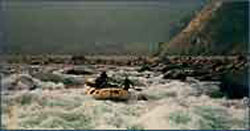 Arunachal Pradesh - this north eastern frontier of India reminds one of the early British explorations in areas inhabited by less than friendly tribals. What springs to mind is the Indo - Chinese conflict, leech infested rainforests and a region of inaccessibility and inhospitability. In fact till the end of the thirties, the region held little attraction except for ethnologists and botanists. The scenario has changed somewhat in the past half century and what is not evident to the uninitiated, is the enormous number of river systems this state provides for the river running enthusiast.
Arunachal Pradesh - this north eastern frontier of India reminds one of the early British explorations in areas inhabited by less than friendly tribals. What springs to mind is the Indo - Chinese conflict, leech infested rainforests and a region of inaccessibility and inhospitability. In fact till the end of the thirties, the region held little attraction except for ethnologists and botanists. The scenario has changed somewhat in the past half century and what is not evident to the uninitiated, is the enormous number of river systems this state provides for the river running enthusiast.
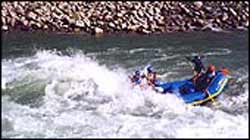 All of us were seasoned river runners but a 45-day expedition on unknown rivers was a factor which contributed greatly to the adrenaline rush over the next six weeks. The team of river guides and kayakers were Vikram Joshi, Jigme Dorje Sherpa (JD) and Vaibhav Kala. Yusuf Zaheer, another experienced rafter, joined us for the first descent of the Subansari. With two 16 foot long Avon rafts, white water kayaks and a great amount of enthusiasm, we departed for Arunachal Pradesh, on a trip which is indelibly etched in our memory as our most memorable exploratory journey. With anxiety bordering on apprehension, we were escorted by the Indian army for the first and second descents of the Subansari, the biggest tributary of the Brahmaputra. After a big tribal dance reception at Taliha, above a quaint little town of Daporijo, we put our boats in, to an awesome send-off celebrating the first attempt to charter this river. The Subansari flows through a densely forested valley with large sandy beaches indicating the high water mark. Completely remote, the joy of descending a valley that no one has visited before, added tremendously to the trip. The rapids rated among the best we had rafted.
All of us were seasoned river runners but a 45-day expedition on unknown rivers was a factor which contributed greatly to the adrenaline rush over the next six weeks. The team of river guides and kayakers were Vikram Joshi, Jigme Dorje Sherpa (JD) and Vaibhav Kala. Yusuf Zaheer, another experienced rafter, joined us for the first descent of the Subansari. With two 16 foot long Avon rafts, white water kayaks and a great amount of enthusiasm, we departed for Arunachal Pradesh, on a trip which is indelibly etched in our memory as our most memorable exploratory journey. With anxiety bordering on apprehension, we were escorted by the Indian army for the first and second descents of the Subansari, the biggest tributary of the Brahmaputra. After a big tribal dance reception at Taliha, above a quaint little town of Daporijo, we put our boats in, to an awesome send-off celebrating the first attempt to charter this river. The Subansari flows through a densely forested valley with large sandy beaches indicating the high water mark. Completely remote, the joy of descending a valley that no one has visited before, added tremendously to the trip. The rapids rated among the best we had rafted.

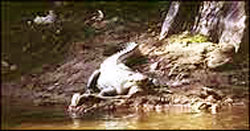 The Brahmaputra commenced its journey perhaps a millenium ago as the Tsangpo in Tibet, much like a ribbon, creeping from near the holy lake of Mansarovar, through the barren stark landscapes, with a golden track. The Tsangpo, in its upper reaches flows gently eastwards hundreds of miles across Tibet prior to its entry into India. Before it enters the state of Arunachal Pradesh, it narrows at a gorge it has sliced over centuries between two giant Himalayan mountains; Gyala Peri (24,443ft) and Namche Barwa (25,445ft). Here, it also takes a big loop to change its easterly course to southerly - this is called the "Big Bend". This gorge is practically un-trekkable and uncharted. Its total length is contained in a 25 mile upper gorge, potentially a death zone with 30 ft waterfalls and continuous Grade V+ rapids. The 15 mile inner gorge has walls as high as 3000 ft while the 80 mile lower gorge has similar characteristics. The Tsangpo, in this gorge pushes volumes upto 2,00,000 cubic feet per second (cfs) and drops at a rate of 150 ft per mile. In contrast, the Colorado river in the Grand Canyon drops at 7 ft per mile.
The Brahmaputra commenced its journey perhaps a millenium ago as the Tsangpo in Tibet, much like a ribbon, creeping from near the holy lake of Mansarovar, through the barren stark landscapes, with a golden track. The Tsangpo, in its upper reaches flows gently eastwards hundreds of miles across Tibet prior to its entry into India. Before it enters the state of Arunachal Pradesh, it narrows at a gorge it has sliced over centuries between two giant Himalayan mountains; Gyala Peri (24,443ft) and Namche Barwa (25,445ft). Here, it also takes a big loop to change its easterly course to southerly - this is called the "Big Bend". This gorge is practically un-trekkable and uncharted. Its total length is contained in a 25 mile upper gorge, potentially a death zone with 30 ft waterfalls and continuous Grade V+ rapids. The 15 mile inner gorge has walls as high as 3000 ft while the 80 mile lower gorge has similar characteristics. The Tsangpo, in this gorge pushes volumes upto 2,00,000 cubic feet per second (cfs) and drops at a rate of 150 ft per mile. In contrast, the Colorado river in the Grand Canyon drops at 7 ft per mile.
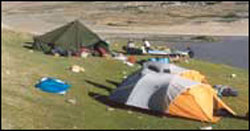 The uncontrolled fury of the Tsangpo however, lessens to a certain extent, but is in no way contained, when it enters Arunachal Pradesh near its border with China near Gelling. The river is now called the Siang. Its journey to the plains at Pasighat, 200 kms away through tribal territory inhabited by the Adi tribe makes this expedition one of the premier wilderness trips available today.
The uncontrolled fury of the Tsangpo however, lessens to a certain extent, but is in no way contained, when it enters Arunachal Pradesh near its border with China near Gelling. The river is now called the Siang. Its journey to the plains at Pasighat, 200 kms away through tribal territory inhabited by the Adi tribe makes this expedition one of the premier wilderness trips available today.
 Day two was a demanding and exciting one with four big Grade IV+ rapids - a day of river guides screaming commands, our crew flailing paddles (hitting mostly air!), rushing adrenaline and the sights, sounds, and smells of world class white water. At the village of Rikor, the villagers trooped down to the river to see our rafts run down the Grade IV+. One of them had seen a raft flip on the Indo-Japanese trip and he offered us the advantage of his experience by pointing out the safer route. The excitement continued as rafts disappeared into rapids, to be seen on the crest of a 18 ft wave, only to go out of sight again - the crew and guide working together to plough head-on into the waves.
Day two was a demanding and exciting one with four big Grade IV+ rapids - a day of river guides screaming commands, our crew flailing paddles (hitting mostly air!), rushing adrenaline and the sights, sounds, and smells of world class white water. At the village of Rikor, the villagers trooped down to the river to see our rafts run down the Grade IV+. One of them had seen a raft flip on the Indo-Japanese trip and he offered us the advantage of his experience by pointing out the safer route. The excitement continued as rafts disappeared into rapids, to be seen on the crest of a 18 ft wave, only to go out of sight again - the crew and guide working together to plough head-on into the waves.
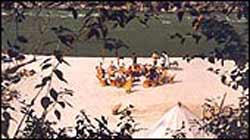 We floated past Karko to reach Geku, a few kilometres below. Camp was made at Geku and another evening was spent talking about the trip, Karko, flips, waves and Old Monk rum. Geku onwards, the river seems to pump a lot more volume. Float sections with the river covered in mist made it an interesting day. The Siang meets another tributary, the Siyom, coming in from the west soon after Boling. We stopped for a packed lunch on a beach soon after and a helicopter flew overhead to ensure that we were still in one piece. It was evening by the time we reached Yembung. A government rest house near the banks was a welcome sight after camping out for the few days before. Yembung has a small market and hot samosas are one of the specialities here. Sleeping on a bed was a novelty on the penultimate night as the scale of our trip began to finally sink in. Celebrations begi-an on this last night of the trip and for the first time there was no speculation about the next days rapids.
We floated past Karko to reach Geku, a few kilometres below. Camp was made at Geku and another evening was spent talking about the trip, Karko, flips, waves and Old Monk rum. Geku onwards, the river seems to pump a lot more volume. Float sections with the river covered in mist made it an interesting day. The Siang meets another tributary, the Siyom, coming in from the west soon after Boling. We stopped for a packed lunch on a beach soon after and a helicopter flew overhead to ensure that we were still in one piece. It was evening by the time we reached Yembung. A government rest house near the banks was a welcome sight after camping out for the few days before. Yembung has a small market and hot samosas are one of the specialities here. Sleeping on a bed was a novelty on the penultimate night as the scale of our trip began to finally sink in. Celebrations begi-an on this last night of the trip and for the first time there was no speculation about the next days rapids.